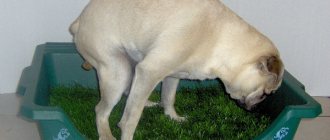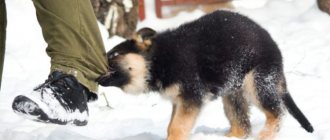In front of the owner, domestic dogs often roll over on their backs and lift all four paws up, exposing their belly in all its glory. The owner is usually touched by such an action and immediately begins to stroke and scratch the pet’s belly. However, according to veterinarians, this should not be done.
Why you shouldn't pet your dog's belly
When should you not pet your dog?
Many of us believe that any touch to a dog should cause him delight or pleasant sensations. In fact, everything happens exactly the opposite. After we touch the dog, we see his strange reaction, he puts his ears back and looks from under his brows. This means that the dog does not like you petting him at all, or the place is not suitable. Perhaps touching makes her feel uncomfortable. Therefore, it is advisable to stop any petting so as not to irritate the dog.
When not to pet a dog:
- When she is in the process of playing, in a playful mood, she runs after a ball or plays with other dogs. In this case, she is not at all interested in affection, she wants to play. In this case, the pet may react inappropriately to your touch. This can serve as a kind of call to play, so your friend can easily grab your fingers or poke your nose into your palm, distracting him by wagging his tail. This means that the dog does not want to be stroked, the main desire is games and fun.
- While eating. The fact is that almost all dogs, no matter how long you have had them, treat food carefully and scrupulously. Many people have noticed that if you approach a dog during a meal, it begins to growl, bare its teeth and threaten. Accordingly, under no circumstances should you touch the dog while eating.
- The dog is sick or sleeping. Any stroking can wake the dog up or aggravate its condition. Therefore, refrain from stroking at such moments. The ideal option for petting a dog is a quiet time after a walk. The dog wants affection only when it is well-fed, clean and has had a walk. Accordingly, it is best to carry out such manipulations after walking, feeding, and bathing the dog.
Games with a pet
What should you avoid when petting?
You already know where and how to pet your dog to make him relax. However, there are also some things to avoid :
- Do not pet your dog when it is very unpleasant for him.
- Never blow on her ears or face.
- Do not press on the base of the tail.
- If your dog has a skin wound or swelling, avoid massaging the area.
- Constantly monitor your dog's reaction. If you feel discomfort or tension (wagging your tail, pinching your ears), it is better to stop the massage.
- Don't tease your dog; most dogs interpret this as a sign of threat.
How to stroke a dog correctly so that it likes it?
How should you pet your dog? Under no circumstances should you move against the growth of the fur.
How to pet a dog correctly so that it likes it:
- The fact is that they can cause discomfort in the dog, so the reaction is ambiguous and inadequate.
- Even the most obedient dog can lunge, growl or run away. Therefore, put off caresses until later, and under no circumstances stroke against the grain.
- Approach the dog carefully in a special manner. The thing is, if you walk too fast, the dog may get scared and interpret it as an attack.
- Therefore, walk with an average, measured and full of confidence gait.
- You must be absolutely calm and not afraid. Dogs do feel fear, which can encourage them to bite or react inappropriately.
Dog's reaction
Why you can pet a dog in different ways
The touch of human hands, even if they belong to a dearly beloved owner, is not always pleasant for the pet. A devoted dog will endure everything patiently, because he cannot disappoint his owner. However, a strange dog will not tolerate the discomfort caused by a person and may growl or even try to bite in response to affection.
Reasons why some touches are not pleasing to pets:
- sharp and impetuous movements are simply frightening;
- rough caresses cause pain;
- touching can be unpleasant;
- the animal is touched in the wrong place (in “forbidden places”);
- bad time for caressing.
The dog may not like affection, but it tolerates it so as not to offend its owner
There is no need to force affection on your dog when he is passionate about something. A dog with a toy or treat in its mouth will react aggressively and viciously. A pet that is unwell, sleeping, or simply in a bad and unsociable mood will not be happy either. Excited by playing with his relatives, the tailed friend will not appreciate any touch at this moment.
Why do dogs love to be scratched when petted?
It is necessary to approach not directly towards the muzzle, but slightly around it in an arc, so as to stand on the side of the dog. The dog will be able to judge the distance and understand that you do not mean harm to it.
Why dogs love to be scratched when petted:
- The owner's touch to the dog is usually always received well. The fact is that this is a sign of affection. In addition, dogs want to feel needed and useful. They are always loyal to their owner.
- Therefore, any encouragement from him is received very well. The dog perceives the stroking of its owner as encouragement and affection. This is a sign that a person is happy with his pet.
- It is best to stroke the area behind the ears and between them. There is no need to stroke the withers; you can stroke the sides with light movements. Try not to touch other places, and under no circumstances make patting movements.
- Try to speak in a calm and confident voice. If you notice that the dog is taking steps back, lowering its ears and looking at you from under its brows, it is best not to annoy the dog and leave it alone.
Dog
How to properly pet a dog
Each dog is individual, you can find out what he likes only through practice. Many pets tend to tolerate unpleasant caresses just out of love for their owners. However, if the animal is satisfied with the tactile contact that is taking place, then this can be quite understood by its appearance (pulling its muzzle behind its hand, putting its side up, etc.) .
If a dog likes affection, then it’s clear from its appearance
Almost all representatives of the dog tribe like touching certain areas of the body:
- between the ears or just behind them;
- sides of the body;
- the area between the eyes from the nose to the forehead, but without touching the sensitive hairs (“eyelashes”);
- chest and neck;
- chin, excluding its very edge.
You need to iron smoothly, gently and softly, you can lightly scratch the selected area. In this case, you should carefully monitor the response of the ward. If he tries to shrink, evade, turn away, is nervous or stands obediently with his eyes downcast, then it is better to stop all manipulations immediately.
Our dog really loved having her ears ruffled, or even better, scratching the inside of her ear. Although there were no ticks there (they checked it several times) and she herself never scratched them with her paws.
Where is the best place to pet a dog to make it feel good?
There are places when stroking which the dog experiences pleasant emotions; it really likes it.
Where is the best place to pet a dog to make it feel good:
- Such places include the area behind the ears, between the ears, between the eyes and on the side of the tummy, chest, that is, on the sides. But there are also places where you should not iron. In most cases, the dog will stand silently and wait for the action to end.
- She does not want to disappoint her owner, cause him discomfort and anxiety. Therefore, in most cases, the pet will simply sit and be silent, with eyes downcast or ears tucked back.
- After you finish petting, the dog will simply walk away. This does not mean that she is pleased, she just tolerates it and does not want to disappoint you. After all, dogs are very attached to their owners.
Pet
Invitation to greeting
When making first contact with your four-legged friend, squat down next to him so that you are at the same level as him and see if he wants to greet you. You should not bend over your pet, this will cause him anxiety and a sense of danger.
Extend your hand, making sure to make a fist. If the animal sniffs it and leaves, then this is a clear sign that it is not interested in any interactions. If the dog remains and begins to nudge you with his nose, then petting can be continued.
"Dad is offended." Agata Muceniece about her relationship with Priluchny after the divorce
“We are still friends”: Derevianko commented on the breakup with his wife
It’s good to wash often: myths about shampoo and hair care that only harm
Is it possible to stroke a dog’s head, nose, scratch behind the ear, stroke its throat, chest?
The most unpleasant places for a dog are the following:
- In the muzzle area. In particular, stroking just below the lower lip and jaw can cause discomfort. In this area there are very coarse hairs that act as sensory organs. This area is extremely sensitive, so touching it may cause discomfort.
- The lower part of the body, in particular in the tail area. There are also certain areas that are mainly stimulated during mating. Therefore, you should not pet your dog in this area.
- Also, do not pet the tail or paws. Almost all dogs experience discomfort when stroking their front and back legs. The area near intimate areas is prohibited. However, some dogs may fall on their back, thereby playing. They love to have their belly scratched. In this case, it is better not to stroke, but to move the nails, that is, scratch the tummy. It is best to do this at the top, and not closer to the genitals, if it is a male.
Games with a pet
Why you shouldn’t scratch your dog’s belly – explained by veterinarians
According to veterinarians, it is generally undesirable to stroke dogs on the belly, as this can lead to unpleasant consequences. There are several reasons why you should not get carried away with this process:
Trespassing
Patting a pet on the belly means invading his personal space. Often owners treat the dog like a fluffy toy and cuddle it constantly. This is especially true for tame dwarf breeds: toy terriers, chihuahuas and others. Owners rarely think about the wishes of their pet. They can touch the animal at any time, pick it up, cuddle it and scratch its belly.
Petting a dog can make it angry and aggressive.
However, the violation of physical space is not to the liking of even the smallest dogs. Complete disregard for personal boundaries causes discomfort for the pet. The owners themselves would hardly give their consent to someone having unlimited access to their body. Constant physical contact is also undesirable for animals. Petting a dog can cause dissatisfaction and deterioration in behavior, even leading to attacks of aggression.
Increased sensitivity
Dogs have very sensitive nerve endings on their stomachs. Because of this natural feature, the animal’s reaction may be ambiguous. Touching this part of the body can cause too much sensation in your pet, especially tickling and patting. They can be quite unpleasant. If the dog finds it difficult to tolerate the owner's stroking, it may snap or even bite him.
Dogs have very sensitive nerve endings on their stomachs.
Sexual arousal
When massaging a dog's belly, many people forget that the genitals are located very close to this place. In most cases, animals do not like to have their genitals touched. This may cause an aggressive response.
Accidental contact with the genitals during stroking usually does not put the animal into a state of delight. But sometimes dogs enjoy stroking the abdominal area near the organs and begin to get excited by this process.
With each touch, the owner can observe the animal's increasingly rapid breathing. The pet begins to lick the person’s hand or lick its genitals. In males, contact of a human hand with the abdomen often causes an erection.
While stroking the belly, you may accidentally touch the dog's genitals, which will negatively affect the dog's condition.
Important! Touching sensitive areas can provoke the dog to imitate sexual intercourse. The desire for sex will cause the animal to become very overexcited. This worsens his character and leads to aggressive behavior.
Constant overstimulation of a dog in the absence of proper discharge leads to the development of various diseases of the reproductive system, including cancerous tumors. Therefore, before stroking your pet’s belly, you should think carefully about the consequences.
Why can't you pet your dog's head?
Many owners may use patting movements rather than stroking. They are usually carried out in the area of the lower body, closer to the tail, or on the sides. Some dogs may perceive patting as punishment. Do not pet or pat your dog on the head.
Why you shouldn't pat your dog's head:
- There is a thin layer of fat on the head and a lot of sensitive areas, touching which can cause discomfort in the dog.
- Any movements in this zone are perceived as rudeness, physical force, and its manifestation.
- Therefore, completely avoid stroking the head and patting the dog; this is in no way a reward for the dog and does not cause pleasant sensations in it.
- You may notice that after performing such movements, the dog curls up its ears and tilts its muzzle down.
- This means that it is unpleasant for her, and it is advisable to stop such actions.
The best places for stroking
As studies have shown, it is best to avoid stroking, and especially patting, the animal’s head and face. You may notice that even your adoring family pup doesn't like it. Usually dogs perceive such gestures as threatening; they do not like it when their personal space is invaded. They especially do not like touching the chin - the place where the hard vibrissae are located and have strong sensitivity.
Instead, it is recommended to run your hand over the animal's fur around the chest, shoulder and base of the neck. And do not touch the area around the tail and belly of another animal, which is a vulnerable spot. A dog may lie on its back to show that it is submissive or afraid, not because it wants its belly rubbed.
Why can't you pet other people's dogs?
Many of us want to pet an unfamiliar dog while walking in the park, or to caress the dog of a friend or neighbor we know.
Why you shouldn't pet other people's dogs:
- It is advisable not to take any active actions without the owner’s permission. Ask about the dog's personality and ask to pet it. Only with the permission of the owner proceed with your plan.
- The fact is that almost all dogs are wary of strangers. What the owner is allowed to do, they do not allow others to do. Some dogs react negatively to any touch that comes from strangers.
- But many people love affection, so they will gladly accept such strokes. In any case, ask the owner.
Frightened dog
Under no circumstances should you approach stray dogs with the desire to pet them. This is an unfamiliar dog who doesn’t know how he will react to your touch.
Be gentle
When giving pleasure to an animal, treat it calmly and slowly stroke it in the direction of fur growth. Don't be rude if you don't know the dog and don't know how he likes to play. All movements should be soothing and have a therapeutic effect for both the animal and the person. There should be mutual benefit from common contact.
A student at the Vietnam Police Academy shared how she takes care of her facial skin.
The money tree pleases with lush flowering: my secret is in caring for the leaves
Smooth and fresh skin: dermaplaning, or why a woman needs to shave her face
A relaxed, gentle and slow stroking style will lead to longer contact. Four-legged animals do not respond well to human interaction when they are excited, meet a fellow animal, or are busy eating. In this case, you need to wait for the right moment to pet the dog.
Physiological reasons
They are often associated with severe discomfort or pain experienced by the dog. Even a calm and affectionate animal can show dissatisfaction or even snap at its owner if it has some health problems, for example:
- Ears hurt. If a dog has developed otitis media, an ear has been injured, or a tick has embedded itself in it, the animal will experience pain that will only intensify when touched.
- Headache. Animals can also have headaches, especially if the dog is prone to weather dependence, which is especially typical for representatives of dwarf breeds.
- Poor eyesight. It may be associated with an eye disease, such as glaucoma or cataracts, or with the breed characteristics of the pet. For example, if the dog has deep folds on the sides of its head, like a Shar-Pei, or the eyes are covered by fur, as is the case with some terriers. In this case, the animal’s field of view deteriorates, and it may become frightened if the owner, or, especially, a stranger, sharply extends a hand to its head.
- Teeth hurt. Due to the fact that the nervous system in dogs is designed in such a way that impulses in the muzzle, ears and eyes pass faster than in humans, the animal very acutely feels pain in the oral cavity. It can cause headaches, photophobia, and ear pain in your pet. And touching your pet’s head or ears will only intensify it.
- Exterior requirements. If the ears of a growing puppy, according to the requirements of the standard, should be erect, but are still hanging, stroking his head is not recommended for the very reason that you can smooth them out. If this happens, then in order to position the ears correctly, you will have to use special means, and sometimes resort to cosmetic surgery.










